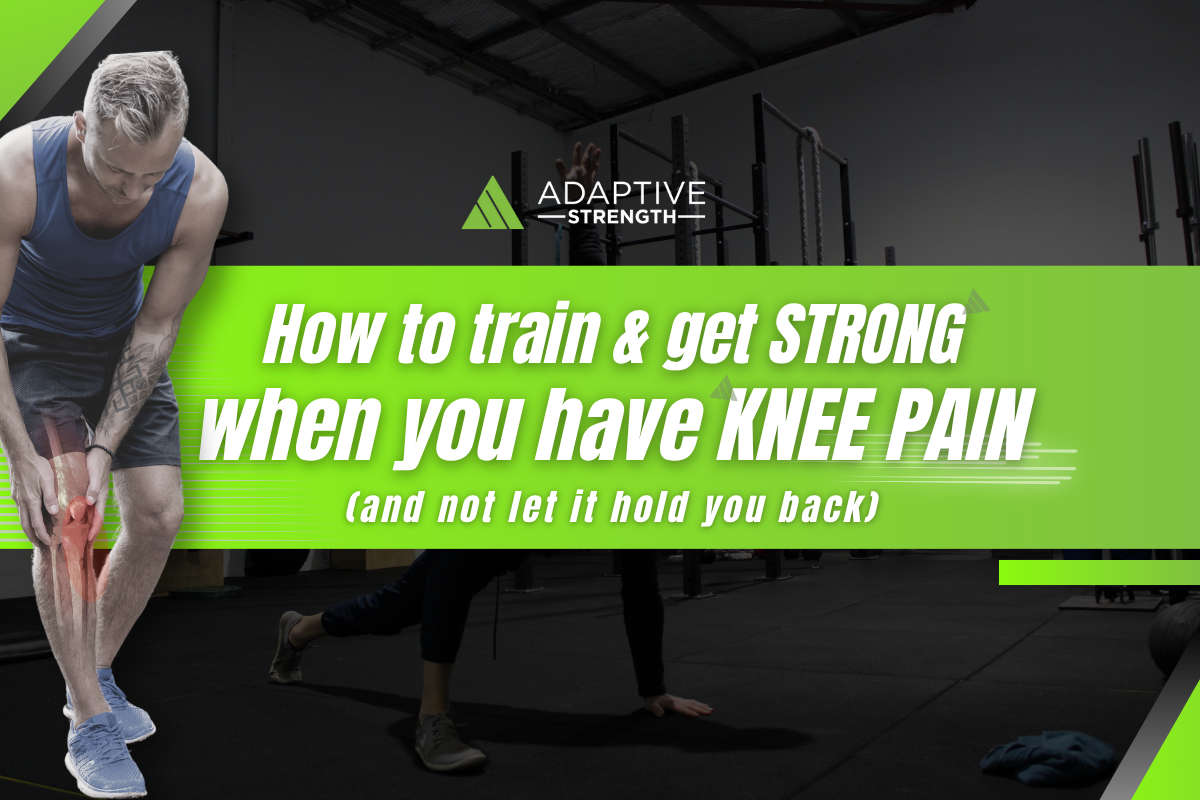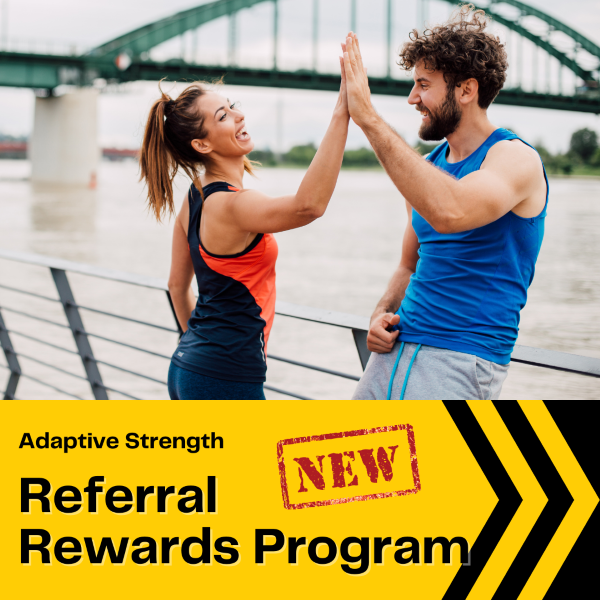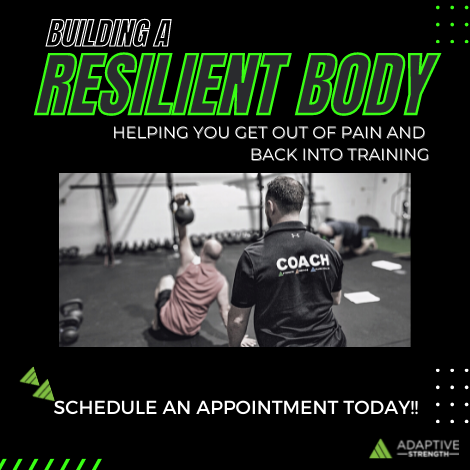At Adaptive Strength, we meet a lot of people who’ve been sidelined by pain. Often it’s the knees — frustrating, persistent, sometimes sharp or “gravelly,” and often just bad enough to rob someone of their confidence to move the way they want. But if you think knee pain means the end of training or building strength, think again.
Let’s take a common example we’ve seen:
A woman in her late 40s walks through our doors. She’s active at heart — used to love training and being fit. But for the past few years, knee pain (especially in the left one) has become a constant companion. The pain is sharp at times, with a grinding sensation behind the kneecap. There’s occasional instability — the kind of feeling where you’re not quite sure if your knee will hold you up. It’s frustrating. But despite the annoyance and limitations, she’s not here just for pain relief.
Her main goal?
To get strong again. Not just her legs — her whole body. She wants to build her core, upper body, and general strength. She doesn’t want her knees to be an excuse. She wants to work around them while doing the right things to make them better.
And that’s exactly what we help people do at Adaptive Strength.
You Don’t Have to “Fix” Everything Before You Start Training
Let’s bust a common myth: you don’t have to wait until everything feels perfect to start getting strong. Many people think they need to “rehab first, then train.” The truth is, when it’s done right, your rehab and your strength training can be the same thing.
When you work with the right professionals — coaches who understand pain, movement, and strength — you can do both at once. That’s the model we follow here. Your program is tailored to you. And your coach isn’t just a random PT running a bootcamp — they’re an Exercise Physiologist, Physiotherapist, or Exercise Scientist who knows how to help you navigate injury and still make real progress.
Train Everything That Isn’t the Knee — And Do It Well
Here’s what we really want you to hear:
You don’t need to be limited by what you can’t do — when there’s so much you can do.
And that’s what we’ll focus on. Not just foam rolling and banded rehab drills, but full-body, high-quality training that builds serious strength where it counts:
🟢 Upper Body Strength
Push. Pull. Carry. Press. Row.
We go hard on these. There’s zero reason to hold back here.
Upper body strength doesn’t just make you feel more powerful — it improves posture, helps you move better, and builds a strong foundation that supports everything from lifting to running to getting off the floor.
You’ll do:
- Overhead presses and landmine variations
- Horizontal and vertical pulling (rows, assisted pull-ups)
- Heavy carries to challenge grip, core, and shoulder stability
🟢 Core Training (Real Core Training)
We’re not talking crunches and planks here. We mean anti-rotation, anti-extension, and total-body bracing — the kind of core work that protects your spine and connects your upper and lower body with strength.
You’ll learn to:
- Brace and resist movement (think Pallof presses, deadbugs, loaded carries)
- Control your trunk under load
- Move powerfully without compensating through your knees or back
Your knee might be the issue, but your core is the solution to more stability and confidence in every movement.
🟢 Hinge-Dominant Lower Body Training
Just because squats hurt doesn’t mean you stop training your legs.
We load the hips, not the knees. That means:
- Romanian deadlifts
- Hip thrusts
- Supported single-leg hinges
- Sled pushes and backward drags
- Step-ups and split-stance work in controlled ranges
These movements strengthen your posterior chain — glutes, hamstrings, adductors — without dumping pressure into your knees.
Done right, you’re still building strong legs, even if you’re not doing full-depth squats or jumping around.
🟢 Smart Conditioning
You don’t need to run or do box jumps to get your heart rate up.
Low-impact, knee-friendly options include:
- Stationary bike or airbike
- Rowing machine
- Sled work
- Assault bike intervals
- High-rep upper body circuits with carries
These are powerful tools for improving cardiovascular fitness, body composition, and mental resilience — and they can be scaled to your current capacity without aggravating your knees.
What About the Knee Itself?
Yes, we’ll work on it — but it won’t dominate your training.
We’ll rebuild trust in the joint. We’ll assess movement quality, identify weak links (like poor hip control or foot stability), and incorporate targeted work that supports better function without flaring things up.
Yes, we’ll modify certain movements. But we don’t avoid everything. There’s a difference between smart training and fearful training. We might reduce knee-dominant movements or tweak ranges of motion to keep you in a pain-free zone. But we’ll still train your legs — because strong legs are part of the solution, not the problem.
While we train around the knee, we’re also quietly strengthening everything that feeds into the knee. That includes:
- Glutes and hips: Poor hip control often leads to poor tracking of the kneecap (that “gravelly” feeling).
- Hamstrings and calves: Stronger muscles around the joint help support and absorb load.
- Foot and ankle stability: Ground-up issues can show up as knee problems.
- Quads — especially VMO: Gradual strengthening in safe positions helps improve knee stability and function.
This is where our rehab and performance worlds blend together. You’re doing real training — adapted for you, overseen by a coach who knows exactly where you’re at, and progressing you step-by-step.
This Isn’t a Group Class or DIY Program — It’s Coaching That Works
You’re never left guessing at Adaptive Strength.
Your coach will guide you every session. Every exercise has a reason. Every adjustment is made based on how you feel — not what the whiteboard says.
And yes, that includes giving your knee what it needs:
- Load when it can tolerate it.
- Support when it’s feeling off.
- Guidance so you can train with confidence, not fear.
The Result?
You feel strong again. You move with confidence again. You get back to doing the things you love — without having to wait for a “perfect” knee.
And maybe, just maybe, you stop thinking about your knee so much — because your body feels strong, supported, and capable.
You Don’t Have to Wait Any Longer
If you’ve been putting off training because of knee pain — stop.
Let us show you how to move forward. Not just carefully, but confidently.
You don’t need to settle for rehab that doesn’t challenge you or training that ignores your pain.
At Adaptive Strength, we specialise in bridging the gap between rehab and performance. We do it with individualised programs, expert coaching, and real accountability — so you don’t just get by, you get better.
Come in for a Free Initial Consultation and let’s create a plan that works for you — knees and all.





